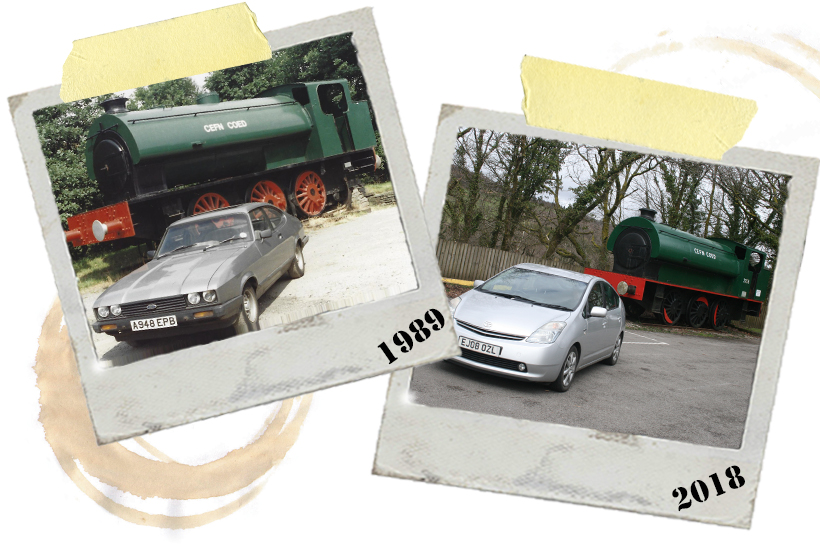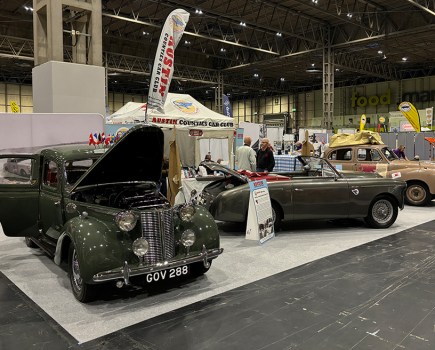Recreating a photograph from 30 years ago prompts Peter Simpson to ponder his Toyota Prius’ classic status…
Over the past 30 plus years I have visited the Neath Valley area of South Wales many times – an old school friend lives there and we tend to get together two or three times a year. My most recent visit was in early May, when I took the attached photograph of my Toyota Prius in the car park of the excellent Cefn Coed Colliery Museum, a few miles up the valley towards Seven Sisters.
The locomotive, by the way, is 0-6-0 ‘Austerity’ number 2578, built by Bagnalls of Stafford in 1944 and which has been the ‘gate guardian’ at Cefn Coed since at least the late 1980s..
The second photograph – featuring a 1984 Ford Capri – was taken nearly 30 years ago, in the summer of 1989. Look closely and you’ll see a significant difference in the engine; in the 1989 shot you can see the boiler under the ‘saddle’ water tank, in the 2018 shot that gap is covered with steel plates. The reason isn’t ‘safety’ as most would probably assume. Rather, the plates are hiding that by 2018 most of the key mechanical components had been removed for reuse elsewhere. Austerity 2578 is now little more than a shell, and no longer has a boiler, cylinders or any of the ‘inside motion’. That’s good – the Cefn Coed engine doesn’t need these for its present role and this way it’s helping to keep other 0-6-0 Austerities alive.
Anyway, I was Deputy Editor of Practical Classics in 1989, and the Capri was a temporary company car; I was between a Triumph TR7 and a Triumph Stag. It was bought originally for the advertisement sales department, but soon became surplus there following ‘staff changes’ and became a general spare car but was retained mainly because, despite being only five years old, it was also considered sufficiently ‘classic’ to be written about.
It produced some good copy, too including coverage of a ‘modification’ which most who owned a Ford around this time will surely recognise. We fitted a Weber carburettor conversion in place of the original and notoriously troublesome Ford VV unit, and at the same time replaced the Ford-fitted automatic choke which was meant to be operated by coolant temperature and a bi-metallic strip with a manual choke which was operated by a black knob on the dash.
Anyway, while setting the Prius up for the repeat shot – sorry it’s not an exact recreation, I was relying on memory – I started thinking a bit about the relative claims to classic status of the Capri and Prius, and in doing so somewhat surprised myself.
As I say, the Capri, despite its relative youth, was fully accepted, chosen at least in part for its classic credentials, and no-one would have disputed its place in a classic car magazine then, let alone now…. Yet, as we’ve just seen, despite 15 years of ‘development’ since the model’s launch in 1969, our 1984 car was still blessed with a couple of significant mechanical issues which owners would need to sort. As well as the carburettor issue, the notorious Ford ‘Pinto’ camshaft issue was up and coming.
My Prius, on the other hand, was bought purely and simply an efficient piece of kit for business and personal transport, and if anything the perceived lack of classic status was a plus-point! It was purely and simply a working car that I would hardly need to think about. It’s also now twice as old as the Capri was in 1989, and currently has 170,000 on the clock, but in the three years and 50,000 miles that I’ve owned it has needed only an exhaust back-box and routine servicing – everything else works exactly as it should. It’s just as much at home around town as on the motorway, supremely comfortable, and consistently returns 60plus MPG. As a car for business and pleasure it’s just about perfect and consequently I’ve come to absolutely love it…
Some may argue that comparing the mechanical durability and efficiency of two cars manufactured nearly a quarter-century apart is unfair; you’d expect the newer car to be better! Yes, that’s true. However it’s also true that whereas the Capri is/was old school – and therefore arguably should have been tried tested and proven technology – the Prius hybrid technology is new – very new – and still breaking fresh ground. Yet despite this, the Prius works – and works really, really well. Far from being the ‘dead after ten years’ cars that many expected, Priuses are rapidly gaining a reputation for massive mileage capability; look in the classifieds and you’ll usually see plenty still going strong with 250,000 plus recorded…
Like it or not, hybrid and electric power are the future as far as personal transport is concerned, even though the question of where and how all the extra electricity needed will be generated has yet to be answered properly. In 20 years, hybrids and electric will be the norm for personal transport, and when this happens I can’t help but wonder if the second-generation Prius will be seen as the car which kick-started it all.
Which in turn prompts the (possibly awkward) question of its classic status now…








